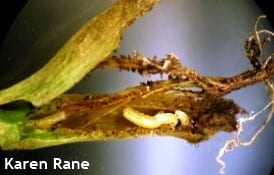Jerry Brust, IPM Vegetable Specialist, University of Maryland; jbrust@umd.edu
There have been several reports throughout Maryland of early planted watermelon and cantaloupe fields with seedcorn maggot (SCM) damage. The damage to transplants is often thought to be just damping-off or some other soil disease, but growers need to split the stems of the plants to see if they contain any seedcorn maggots. Stems can contain 12-45 maggots. The stem often looks whole above ground level, but below ground the stem and roots are often shredded (Fig. 1). The seedcorn maggot is an early season pest of many different crops. Most of these crops are direct seeded, but transplants are also attacked. It is more of a problem during damp, cool periods and in fields with manure or decaying residue. This year has been perfect for the fly to cause damage as we had a very early warm up followed by a cool down. This caused growers to start earlier and it also caused more of the pest population to become active early.
The seedcorn maggot is a pale, yellowish-white maggot found burrowing into seeds or transplants. Full grown maggots are legless, about 1/4 inch long, cylindrical, narrow and tapered. Maggots lack heads and legs, but have small black mouth hooks in front (Fig. 2).
The seedcorn maggot spends the winter as a larva inside a puparium in the soil. When mature, maggots pupate and emerge in April and May, mate, and lay eggs on moist soil high in organic matter, near decaying vegetation or at the base of transplants. The adult, which resembles a small house fly, is a gray to brown fly about 1/5 inch long that can be seen flying over freshly worked soil or where manure has been spread.
Seedcorn maggot eggs hatch a few days after being laid, and small, white, tapered maggots begin to feed on and burrow into plants or seeds. The maggots usually feed for 2 to 3 weeks before pupating in the soil. Adults emerge from the pupal case in about 7 to 14 days, mate, and begin a new cycle. The entire life cycle is as quick as 21 days, resulting in 3 or more generations each year.
There are no rescue treatments for infested plants. Fumigation and soil insecticides do not do a very good job of reducing SCM infestations since the maggots attack the seedling just below soil level. Even the use of systemic insecticides does not completely control maggot infestation s if the weather is cool and damp. The best control is a warmed soil. My research has shown that when temperatures reach 71oF at a 4 inch depth under BLACK PLASTIC, flies will stop laying eggs and larvae do not survive well. Row covers over the newly set transplants will also work to keep flies from laying eggs in the transplants.
Figure. 1 Transplant damaged by seedcorn maggot
Figure. 2 Maggots inside split stem of cantaloupe transplant


